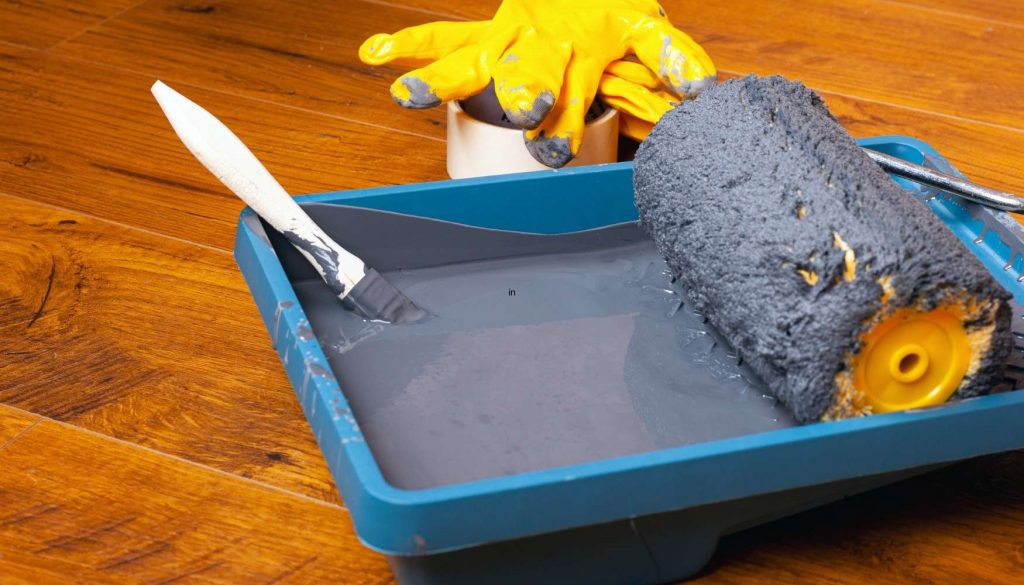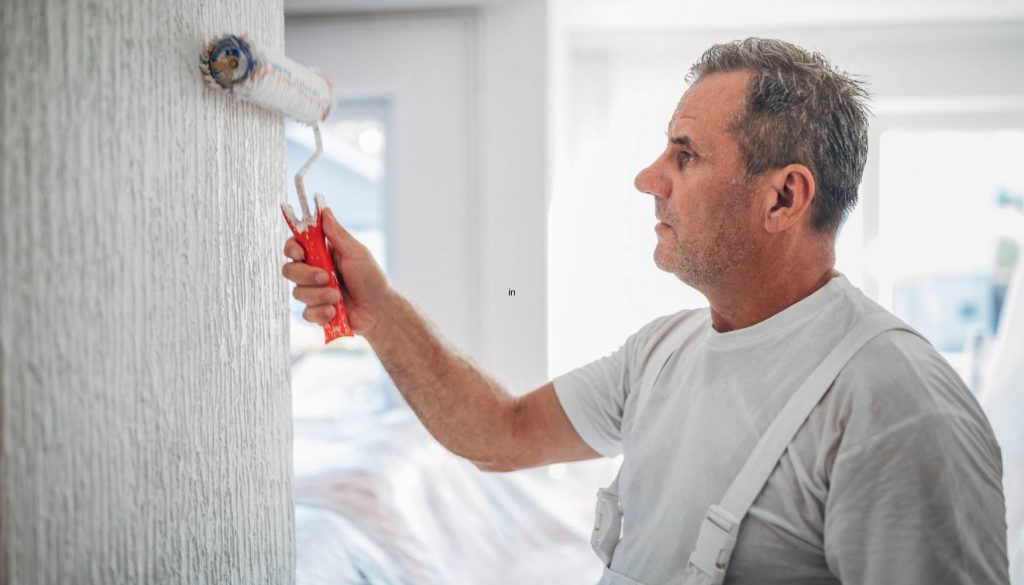You’ve watched one too many home improvement shows — and it’s time for your own fixer-upper painting project.
But what kind of paint should you use? You’ve already got a ½ gallon of paint left from another project sitting in the garage.
Does it matter if it’s interior or exterior?
The answer is …
Yes! It matters greatly, and we’re here to turn you into a painting expert in no time.
Keep reading to learn from our experts about interior vs. exterior paint.

Table of Contents
- Is There a Difference Between Interior and Exterior Paint?
- The 4 Basic Ingredients of Paint Explained
- The Basics of Interior Paint
- The Basics of Exterior Paint
- Breaking Down Exterior Paint vs. Interior Paint
- Toxin Levels
- Cleanliness
- Dry Time
- Resistance to Weather
- Durability
- Indoor vs. Outdoor Paint: Does it Matter Which One You Use?
- Can You Use Interior Paint on the Exterior?
- Why Would You Not Use an Exterior Paint Indoors?
- A1 Paint Removal, Painting & Restoration: Painting Homes Inside and Out Since 1995
Is There a Difference Between Interior and Exterior Paint?
Interior and exterior paint are different in many ways.
But you can find the same four basic ingredients in all paint:
- Solvent
- Resin
- Additives
- Pigment
The solvent evaporates as the paint dries — leaving behind the resin, additives, and pigment.
The major difference between interior and exterior paint is in the resin and additives.
Painting professionals know which type of paint is best to use on any given surface. This article breaks down the basics of interior vs. exterior paint for you — but if you’re ready for the pros to assist, our A1 painting specialists would love to consult with you.
The 4 Basic Ingredients of Paint Explained
#1: Solvent
A solvent is a liquid substance that holds the binder and pigment in suspension until the paint sets.
In oil-based paint, the solvent is organic material such as a paint thinner. In latex paint, water is the solvent.
#2: Resin
The purpose of the resin (or binder) is to bind the pigment particles together to form a cohesive layer after the evaporation of the solvent.
It strongly influences other properties such as:
- Gloss
- Toughness
- Flexibility; and
- Durability
Resins can be natural like:
- Kauri
- Damar
- Ester
- Lac
- Rubber
Or Resins can be synthetic like:
- Epoxy
- Alkyd
- Acrylic
- Polyurethane
- Silicone
- Phenolic
#3: Additives
Additives are the special components of paint that give additional characteristics to the paint.
The purpose of using additives is to:
- Improve the production and storing properties
- Reduce the drag of the paint
- Make the paint flow well on a surface
- Add texture to the paint
- Make it water-proof
- Help with odor for interior paint
- Enhance the adhesive properties for special surfaces
#4: Pigment
Pigments give your paint color.
To avoid adding extra chemicals into the paint mix, interior paint uses organic pigments. These are safe to breathe with no harsh odors.
Exterior paint needs durability and fade-resistant color, so non-organic pigments are needed to be added into the mix. These pigments help deliver the intense odors you’ll smell in exterior paint.
The Basics of Interior Paint
Between …
- Kids
- Pets
- Furniture
- Vacuums; and
- Everyday life
… our walls and interior paint can take a beating.
Good interior paint withstands:
- Staining
- Yellowing
- Fading; and
- Can be wiped and cleaned
Interior paint is usually water-based (latex paint) rather than oil-based.
The Basics of Exterior Paint
Exterior paint has got to hold up to:
- Rain
- Snow
- Wind; and
- Temperature changes
In the past, most exterior paints were oil-based. This resulted in a more durable finish. But thanks to modern technology — oil-based is out, and water-based is in for exterior paint.
Acrylic resins aid in binding, making it just as durable as before. As a bonus, the drying time is much faster with water-based exterior paint.

Breaking Down Exterior Paint vs. Interior Paint
Toxin Levels
If you’ve ever gotten a headache or dizziness after being near paint for a long period — then you’ve been exposed to the chemical gases that release into the air as the paint dries.
This is caused by VOCs (volatile organic compounds). Exterior paint has a larger amount of VOCs than interior paint.
Exterior paint also has extra resins and additional additives to make it more durable for the outdoor elements. These result in off-gassing while the paint dries for a few days — and will continue to release slowly for up to several years.
Cleanliness
Interior paints are normally simple to clean depending on the finish:
- Semi-gloss
- Great in kitchens, bathrooms, and trim with a high durability
- Satin
- Great in bedrooms, family rooms, and hallways with a high durability
- Eggshell
- Great in dining rooms and living rooms with a medium durability
- Flat
- Great for adults’ bedrooms and low traffic areas with low durability
Exterior walls are usually more difficult to clean as they are water-proof. It may require a little more elbow grease and special cleaning products.
Dry Time
With the majority of exterior paints being water-based now, both interior and exterior paint have about the same drying time. If it’s particularly hot outside, exterior paint could dry quicker than interior paint.
Both interior and exterior paint should be dry in about 1 hour, and a second coat can be applied in about 4 hours.
If your exterior paint is oil-based, it could require 6 to 8 hours to dry, and a second coat would need to wait 24 hours before applying.
Resistance to Weather
Exterior paint has more additives to fight against the outdoor elements.
It has to be able to resist moisture from …
- Rain
- Snow; and
- Wind
… and be able to tolerate both temperature drops and quick increases. It also needs to maintain its color — even after hours in the sun.
Unlike exterior paint, interior paint doesn’t include these weather-proofing additives. It isn’t expected to deal with the harsh and changing weather conditions.
Interior paint:
- Has low temperature-resistance
- Low water resistance; and
- Fades quickly in sunlight
Durability
Interior paint uses rigid resins. This leads to not only easier cleanup, as previously discussed, but also aids in making it stain resistant.
Interior paint can withstand occasional scrubbing and cleaning, but it’s not meant to fight against outdoor elements.
Exterior paint uses softer and more flexible resins. This helps to resist mildew, peeling, and chipping. That flexibility also allows the paint to contract when exposed to moisture.
Exterior paint is meant to withstand years of weather changes. Using the right exterior paint can give you many years without having to worry about repainting.
Indoor vs. Outdoor Paint: Does it Matter Which One You Use?
Although you can use the different paints interchangeably — it isn’t suggested.
There’s enough difference in each type of paint that using the wrong paint can be harmful to your health and end up costing more money for repairs down the road.
Can You Use Interior Paint on the Exterior?
You can — but using interior paint on exterior surfaces isn’t recommended. The contents of exterior paint make it resist the outdoor elements such as:
- Rain
- Wind
- Snow; and
- Temperature changes
It’s also specially made to resist outdoor issues like:
- Mildew
- Peeling; and
- Chipping
Why Would You Not Use an Exterior Paint Indoors?
Exterior paint is formulated to stand up to all kinds of weather conditions. It contains resins that help the paint expand and contract. These additives are not intended to be used indoors — and can prove to be harmful to breathe in.
A1 Paint Removal, Painting & Restoration: Painting Homes Inside and Out Since 1995
Before you begin any painting project like …
- Paint removal
- Interior painting; or
- Exterior painting
… it’s always best to consult a professional.
Each type of paint is meant for a specific purpose. Using the wrong type of paint for your project can result in a costly repair.
No matter what your painting project is, the pros at A1 can get it done.
Give us a call today. We’ll schedule a free visit to discuss your wants and needs. And we’ll provide you with an easy-to-understand free estimate — with no hidden fees.
A1 is the clear choice for all residential or commercial painting needs.




